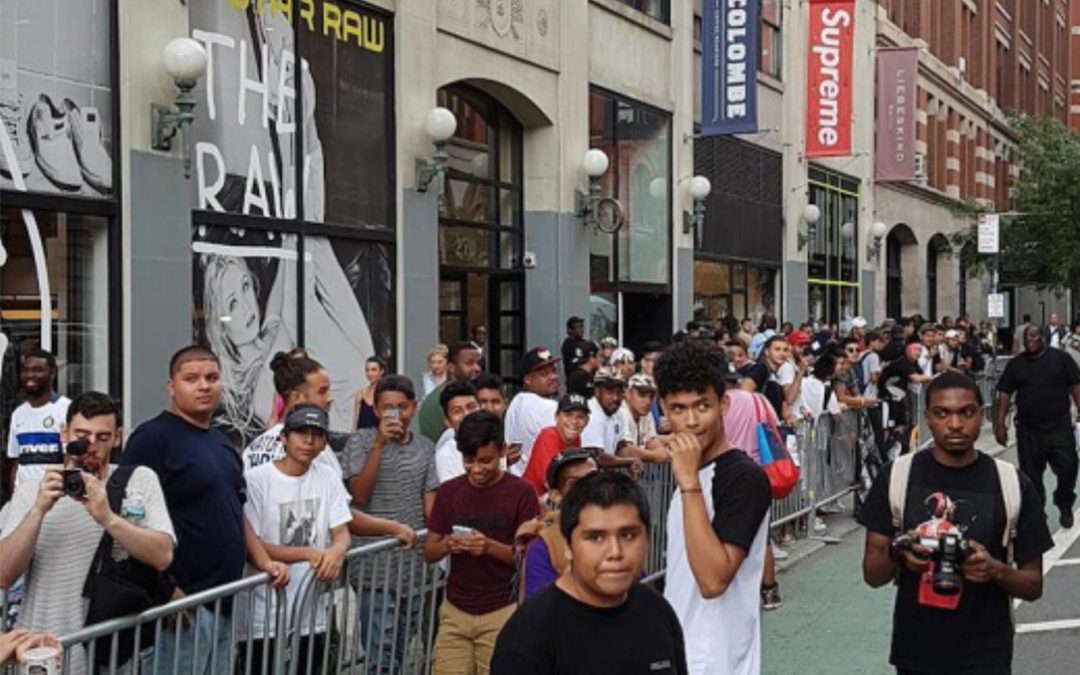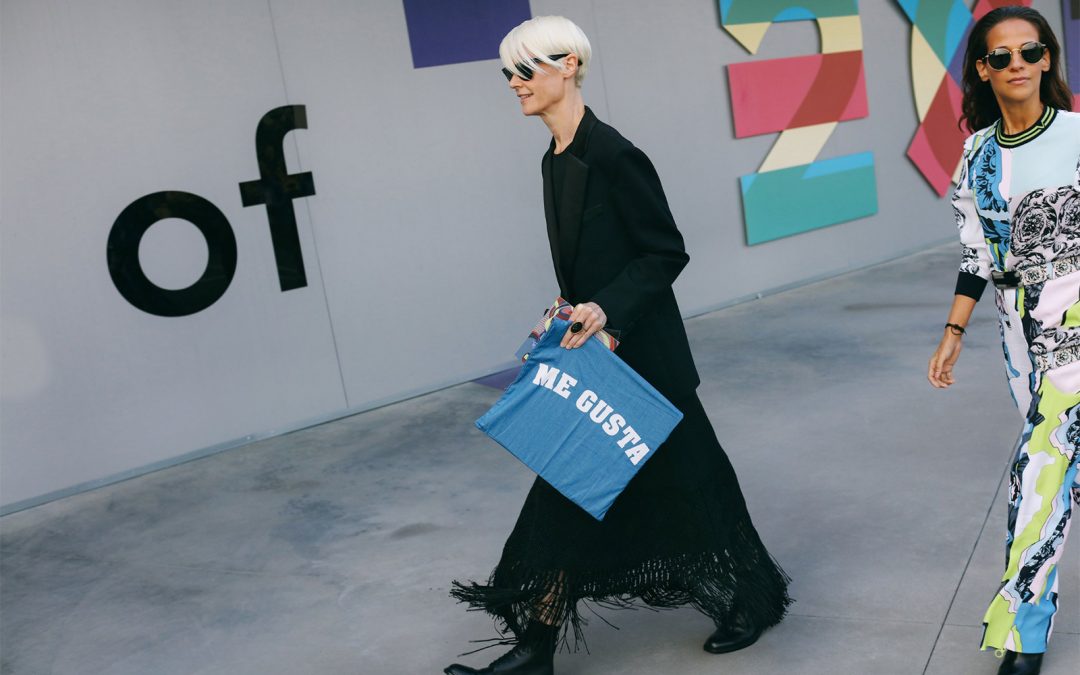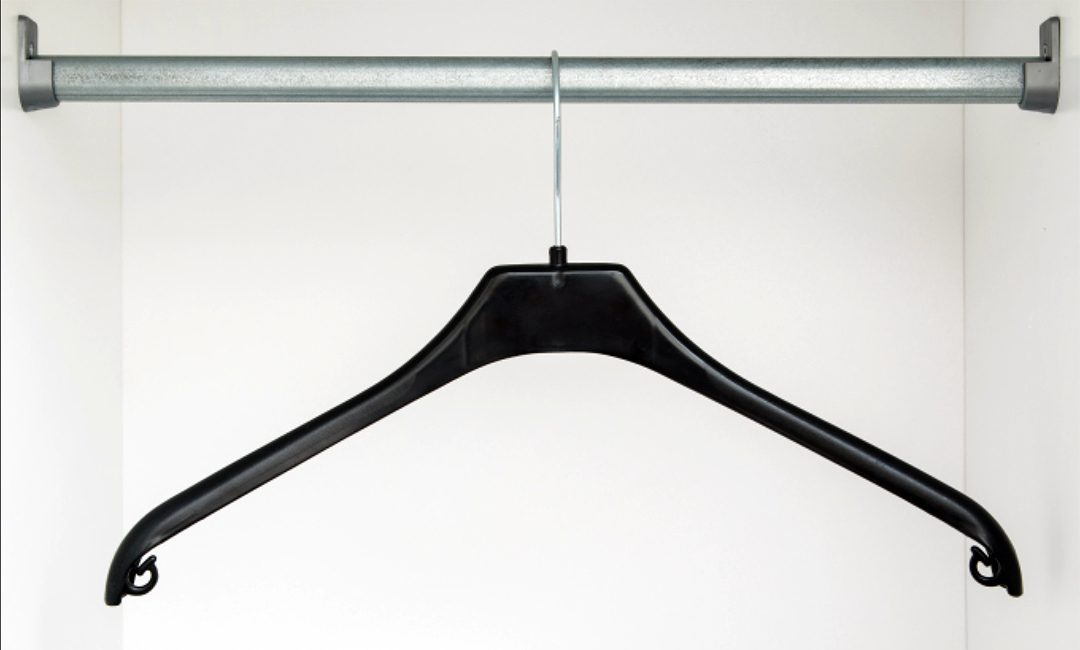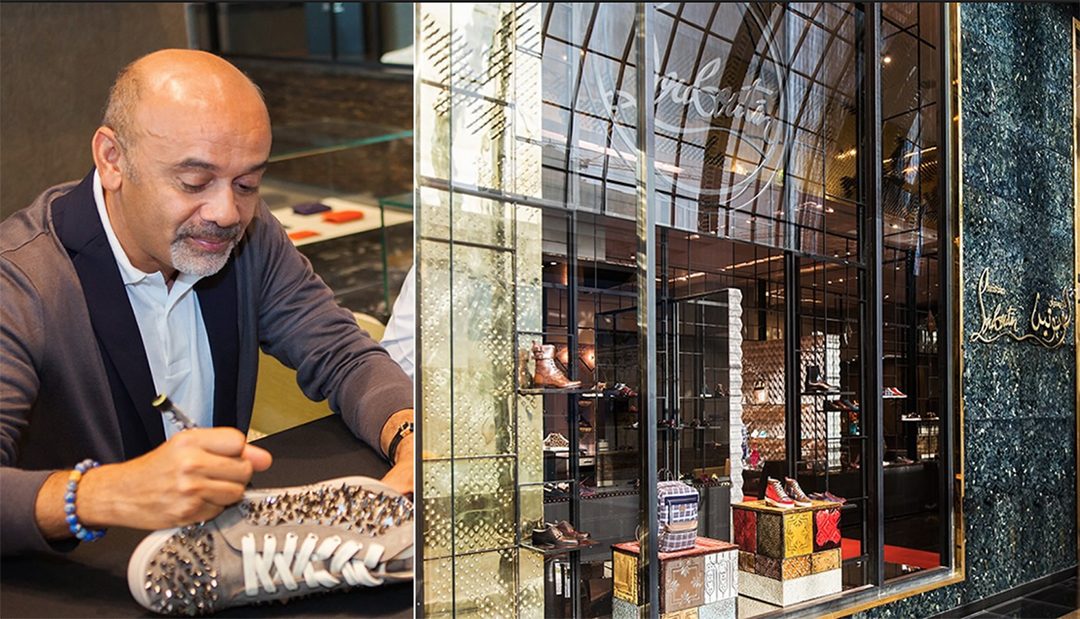
by Cwe | Mar 22, 2017 | Advertising, Art, Branding, Concept Stores, Creative Process, Retail, Trends
On March 22, PLEASE DO NOT ENTER’s “Boutique Ephémère” infuses a downtown Los Angeles twist to the West Hollywood landscape, through a bold graphic, musical and architectural installation by French LA-based artist Sébastien Léon, bringing a new sense of place to the iconic Melrose Avenue building, through graphics, sound, and light.
Léon’s intervention starts with the wrapping of both the entire facade and the two adjacent billboards, with his signature line art in bright pink. One of the billboards features the provocative statement, “Hey B*tch I’m From Downtown”, as an affirmation about the blossoming renaissance of the Downtown art and fashion scene, and the geographic origin of Please Do Not Enter. The installation continues with a multichannel sound installation which the artist composed in collaboration with sound designer Machine Head. The duo transforms the wood ceiling of the boutique into a soundboard, playing a cinematic soundscape inhabited by squeaking planks and flamenco steps. Léon adds a final touch by bathing the whole interior of the boutique with bright pink LED lighting, offering a vivid impression to both visitors and passersby.
8382 Melrose Avenue, Los Angeles CA 90069 (West Hollywood)
The store will be open from Monday to Sunday (11am-6pm) till May 31, 2017.

by Cwe | Nov 6, 2016 | Branding, Retail, Street Style, The Business of Fashion
What the Fashion System Can Learn From Supreme-Style Product Drops
Most people with knowledge of the streetwear market are familiar with the concept of a “drop,” a controlled release of new product at a clip that’s far faster than the traditional fashion cycle and designed to drive consumer excitement with a stream of constant newness. It’s one of the reasons lines at Supreme stores tend to snake around the block every Thursday morning, when the company releases new items.
Supreme, which is vertically integrated and controls the vast majority of its distribution, creates seasonal collections, but drops new product in weekly batches. These drops generate so much interest that entire forums are dedicated to celebrating purchases and guessing which particular pieces will sell out first. What’s more, on the first “drop day” of a new season, traffic to the brand’s website can spike by as much as 16,800 percent, according to Samuel Spitzer, who leads Supreme’s e-commerce operation. E-commerce has become an important part of the business and while Supreme does not disclose sales figures, Spitzer says that on drop days “we get a very, very high rate of orders per second.”
According to Chris Gibbs, owner of multi-brand retailer Union Los Angeles, the system of “drops” stems from a cluster of Japanese streetwear labels, including Hiroshi Fujiwara’s Goodenough, Nigo’s A Bathing Ape, Jun Takahashi’s Undercover, Hiroki Nakamura’s Visvim and Shinsuke Takizawa’s Neighborhood, which all set up shop in the backstreets of
Tokyo’s Harajuku district in the early 1990s and were, themselves, inspired by the DIY methodologies of Vivienne Westwood and Malcolm McLaren’s legendary London store Sex, as well as Fujiwara’s involvement in the International Stüssy Tribe.
You want to try to give customers a sense of consistency and create excitement.
“Japan’s streetwear is very retail-based. They’re thinking about the end consumer at the very beginning and all throughout the process. They’re thinking what the retail price is when they’re looking at the fabric,” says Gibbs. “That culture and that market is more organised from my experience,” adds Ryan Willms, who handles marketing and art direction for Stüssy’s North American operation.
“There’s just so much product releasing at all times that you want to try to give customers a sense of consistency and create excitement,” continues Willms. “People are a lot more aware and the customer just demands a lot more now. I think they just want more product more often.”
In addition to delivering new items every week, brands like Supreme and Palace, a London-based streetwear label, keep distribution tight and quantities limited, undersupplying demand. Together, the strategy generates excitement and encourages customers to constantly re-engage, creating a kind of consumer ritual.
For Brendon Babenzien — previously the design director at Supreme, who, after a 10-year hiatus, relaunched his label Noah in October 2015 — the decision to embrace weekly drops was rooted in practicality. “We’re small. You don’t want to have a tonne of stuff at once. This is just an honest, genuine way to do business: Here’s what we need now, let’s put it out and let’s continue bringing product in throughout the season when it makes sense.”
At a much larger scale, Stüssy has made a concerted effort to drop new product on a weekly basis, but Willms says the process is not without its challenges and requires close coordination with suppliers. “We see from the outside Supreme does a good job, but I’m sure behind-the-scenes they’re scrambling around to get some of those things done on time as well,” he adds.
“Brands like Supreme and Palace don’t follow the same seasonal calendar as high fashion brands at all,” observes James Gilchrist, general manager of Comme des Garçons USA and Dover Street Market New York, which stocks both brands. “Actually, their approach makes a lot of sense compared to the way high fashion brands are currently delivering.” As Gilchrist points out, traditional fashion deliveries are structured around far fewer,
bigger shipments.
You don’t want to have a tonne of stuff at once… Let’s continue bringing product in throughout the season when it makes sense.
Gosha Rubchinskiy, a buzzy brand operated by Comme des Garçons, has fused the traditional delivery schedule with something closer to how streetwear brands like Supreme operate. “This was just how things naturally developed; it was not an intentional part of a strategy,” says Gilchrist. “Gosha does a fashion show and is a wholesale business, so he has to work to that calendar and the collection is separated into deliveries in the showroom that govern when certain things will drop. However, the distribution and the quantities produced are very tightly controlled and limited in a similar way to Supreme or Palace.”
Rubchinskiy also makes exclusive product for Dover Street Market that is released throughout the season, further fostering a sense of newness. But Gibbs says Rubchinskiy’s delivery schedule isn’t that different from the rest of Comme des Garçons’ labels, which are typically delivered in four batches throughout a season. As a result, he’ll rarely order from Rubchinskiy’s fourth delivery, since by the time it ships to Union, the store has most likely already begun marking down product.
Gibbs says the drop model works better for vertically integrated businesses, as piecemeal delivery of a collection can be challenging for both multi-brand retailers — which pride themselves on maintaining a carefully calibrated merchandise mix — and brands that depend on wholesale distribution for a significant chunk of their income.
But like Rubchinskiy, Los Angeles-based designer John Elliott, who splits his label between a core line of basics and a seasonal collection that gets shown on the runway, has adopted a hybrid approach. Elliott ships his core product — including t-shirts, knitwear and sweatpants, which comprises 60 percent of his business — to department stores on the traditional calendar, but also does a healthy direct-to-consumer business based on weekly drops via his own e-commerce site. On Mondays, Elliott’s website is updated with pieces from his seasonal collection. On Thursdays, higher volume items like t-shirts, hoodies and sweatpants are released in new colours. Traffic to the site increases by an average of 60 percent on “drop days” over other days, says the company.
“For us it’s a result of probably three things,” explains Elliott. “One would be cash flow, two would be the fact that we produce 90 percent of our stuff in a really small factory in Los Angeles and the third would be that if we were to drop [the collection] all at once, our customer would choose some big winners and probably pass on some stuff.” The
approach also means Elliot can drop product like coats and heavier knits when it’s more seasonally appropriate, he says. In addition, the system allows the label to shine a new light on different items each week, which has helped to boost sales for non-core categories like denim.
What’s more, Elliot feels weekly drops lend themselves to a strong marketing narrative. For each drop, the label shoots a new lookbook, then delivers each of the featured items, a process that requires a lot of planning with regards to production schedules and purchasing. “The most value is in showing a collection, telling a story and giving your customer a taste of what’s to come.”

by Cwe | Oct 26, 2016 | Branding, Marketing, The Business of Fashion
Product Branding and Marketing according to Seth Godin:
Understand the Action Theory
Create a plan that follows the four steps of Action Theory Marketing.
Emotion Change Alert Share
Understand the P’s
Positioning
Your brain is crowded.
● Find a niche and fill it.
● You cannot force yourself into someone’s brainmost people aren’t going to invent a new
slot just because you want them to.
● Your goal is to find a niche, find a slot in a ‘file’ that already exists.
● What does the marketplace look like to someone who cares? — it’s a very different focus
than the person who’s merely hurrying by…
● Price ought to be based on perceived value, not cost.
● Price is only a hint or a quantified signal. You lose when you race to the bottom, mistaking
cheap for a brand promise… The opportunity for the marketer is to use price as a signal that supports the story and the promise that they intend to make.
Placement
● Invest money to be right next to the people you want to be next to, whether it’s shelf space or ‘life space’. Proximity changes the way people see you.
Promotion
● Trial creates an emotion in the consumer, and enables them to spread the story they want to spread. Carefully choose who to offer this generosity to, and get the leverage to spread your idea.
Purple
Make something worth talking about.
Publicity
● You don’t get to decide if your product or service is remarkable, the consumer does.
● Don’t walk around insisting that you’ve made something remarkable, instead watch to see if
people choose to talk about it.
● The magic of pushing a story to get free media is fading. Too many outlets, too much clutter.
Public relations
● PR is not the same as publicity. PR is the act of telling a story.
Placebo
● If you think something will work, it works better. the placebo effect is responsible for half of efficacy of many drugs.
Pavlov
● Ring a bell?
● Create a Pavlovian reaction: We do this, you get that. This often leads to a placebo effect. Train
people to expect something.
Persistence
Frequency + Consistency.
Place
● Showing up over time builds trust.
● The time to change your marketing is not when your people are bored with it, but it’s when
your accountant tells you to change your marketing.
● A persistent, frequent approach to the market makes us believe you and trust you. You lose
all of that when you cross the line to annoying.
● What is it like to be with you?
● Real estate creates value on top of the service offered.
● When you think about how you’re going to engage with people, what do you want to remind
them of?
Personalization
● Now that you know about your customers, you can treat them differently.
People Like Us
● Do people like us do something like that?
Choose seven (or even just three) of the fourteen “P”s and decide how they will be the backbone of your marketing plan.
These elements are the ones that make you special, that are your ticket to success.
What is your brand’s foundation?

by Cwe | Jul 29, 2016 | Branding, Marketing
A digitally-native vertical brand meets four criteria:
- It’s primary means of interacting, transacting, and story-telling to consumers is via the web. In almost all cases the brand is born digitally. Hence the term digitally-native.
- It’s a brand, and that brand is vertical. The name of the brand is on both the physical product and on the website. It requires the commercialization of an e-commerce channel, but that channel is an enablement layer, it’s not the core asset.
- The DNVB is usually maniacally focused on customer experience and on customer intimacy. The experience tends to be three-part bundle of physical product, web/mobile experience, and customer service that collectively become the brand in the consumer’s imagination.
- While born digitally, the brand rarely ends up digital only. This means the brand can extend offline, eventually. Usually its offline incarnation is through its own experiential physical retail or highly selective partnerships. In nearly all cases of partnerships, the brand controls its external distribution versus being controlled by it.
As an investor community, too often the DNVB is compared to a typical e-commerce company. If a typical e-commerce company is a frog, at birth a DNVB does look a lot like a tadpole. But it doesn’t end up as a frog. The difference is profound, and it requires an appreciation the role brand plays in inspiring people, speaking to them, and shaping their choices.
It also requires venture investors to look more closely at the downstream math of a DNVB versus an third-party e-commerce purveyor. That difference in the unit economics is so meaningful that you can hardly compare the businesses. Just because they both have LTV and CAC ratios does not mean they both have the same potential value to the consumer in the medium to long run. The third-party stories are flashier at first on the top-line (more brands!), but the long run winning strategy may well be more focus (building a brand monotheism).
Furthermore, while third-party e-commerce requires you to compete against a grizzly bear called Amazon, creating a DNVB gives you an opportunity to combine the growth of being an e-commerce company with the margins of being a brand, and with a proprietary selection of merchandise where you control distribution and your own destiny. Moreover, when done right, aka where there is some differentiation in the core physical product made possible by the DNVB nature of the model (and this is the key thing entrepreneurs get wrong in starting DNVBs the world doesn’t need), the model enables a better experiential bundle than consumers have ever seen before and can begin to turn entire industries on their head. This creates a brand loyalty impossible to create in the commoditized world of “channel.”
In the history of DNVBs, it’s incredibly early. We are still in the first decade of a multi-century macro trend where retail is re-organizing from around the automobile to around the smartphone. Vertical brands were a huge part of the last era of retail (Zara, Ikea, Gap), aka the offline one, and now they become the driving story in the future of digital retail. The moving parts in the shifting retail landscape are right in front of us to see. What is not appreciated is that the best opportunities may accrue to entrants rather than existing players. The creation of the DNVB becomes a profound opportunity for investors, entrepreneurs, and consumers alike.






